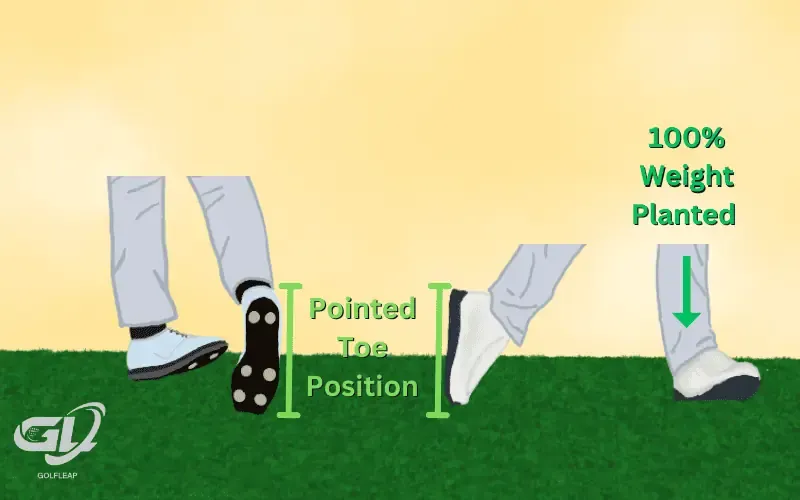
The follow-through is the ending motion and the finishing position of your body once you’ve made contact with the golf ball and completed the golf swing release. In short, think of it as the signifier that the golf swing is completed.
A smooth, balanced, and controlled follow-through creates more consistent and repeatable flush contact for much better golf. You’ve likely heard this before, but how you end the swing sums up the type of golf shot you’ve made.
In short, the ideal follow-through position should have the following:
- A Pointed Toe Position With the Trailing Foot
- The Belt Buckle and Right Knee Should Face the Target
- The Hands are Never Below the Shoulders
- The Club is Pointing Pass Your Original Ball Position
- Both Your Thighs Meet At the Finish
- Standing Tall During Your Follow Through
1. Pointed Toe Position With the Trailing Foot

We can all imagine the picturesque “pointed-toe golf swing follow-through position,” but how do we accomplish it?
Personally, we try to feel nearly all of our body weight (80%) on our leading leg as we’re striking the ball, along with our hips, chest, and shoulders rotating through impact.
A proper weight shift during your swing and the body’s momentum pulls and rotates you to face the target after contact.
From post-impact to the end of the golf swing, 100% of our weight has transferred to our front leg and our body mass has moved toward the target, pulling our trailing leg to its pointed toe position.
Detailed Guide Here – Weight Transfer in the Golf Swing
2. Belt Buckle and Right Knee Face The Target

If your mobility isn’t compromised and you’ve followed our previous pieces of advice, this should be no problem for you. A proper follow-through is a sign of a full golf swing rotation and is quickly assessed with the belt buckle and the right knee (for right-handed golfers) naturally facing the target. For some, you may notice the belt buckle points slightly left of the target, that’s completely fine if it feels natural.
Failing to rotate properly most often leads to poor contact quality and sliced golf shots due to an open club face.
3. Hands are Never Below Shoulder Level

A fundamental to always have in the follow-through is the positioning of the hands above the leading shoulder. Your hands should never sit below or even leveled with the shoulder.
Keeping the hands above the shoulder helps maintain your balance, maintains the swing plane, and prevents an overdominant right hand.
4. Club Points Pass Your Original Ball Position
A good place to point the club at the finish is anywhere beyond where you originally placed the ball before swinging.
Often you’ll see golfers pointing the club at the target.t Though this a beautiful finishing position, it is not a position that we must achieve unless it is natural to you, or else it can lead to serious back injuries (speaking from experience). What’s important is staying balanced and meeting the other criteria we mentioned for the follow-through.
5. Both Thighs Meet At the Finish
The only part of the golf swing where both thighs would ever make contact is during the follow-through. This checkpoint is key to ensuring adequate rotation of the hips and that you are not slouched over at the finish. If your thighs aren’t meeting you’ve likely been swinging the club with your hands instead of the hips and upper body.
6. Stand Tall During Your Follow Through

A consequence of poor mobility, flexibility, or swaying during your golf swing is having a hunched-over, unbalanced follow-through that often causes low and high-spinning golf shots as a result.
Lower handicap golfers often look like better golfers simply through the taller posture and better balance they maintain through their follow-throughs.
A great reminder we tell ourselves when our follow-through is feeling unbalanced or bent over is to try and create a tall, straight, balanced line from our leading leg all the way through our spines.
Follow Through Drill – Walk Through Drill
When we’re finding it hard to maintain balance through impact and our follow through or getting our belt-buckle, chest, or shoulders to face the target we implement the famous Walk Through Drill.
- Creating your standard golf stance, complete your backswing and downswing to impact as normal.
- As you make impact (either taking practice swings or actually hitting balls), release your trailing foot from the ground and take a small step toward the target.
The “Walk-Through” ending position of the drill does all but guarantee your hips and body’s center are pointed toward your target and your momentum and body weight are fully on your leading leg, helping you engrain what you’re supposed to feel during your swing’s follow through.

